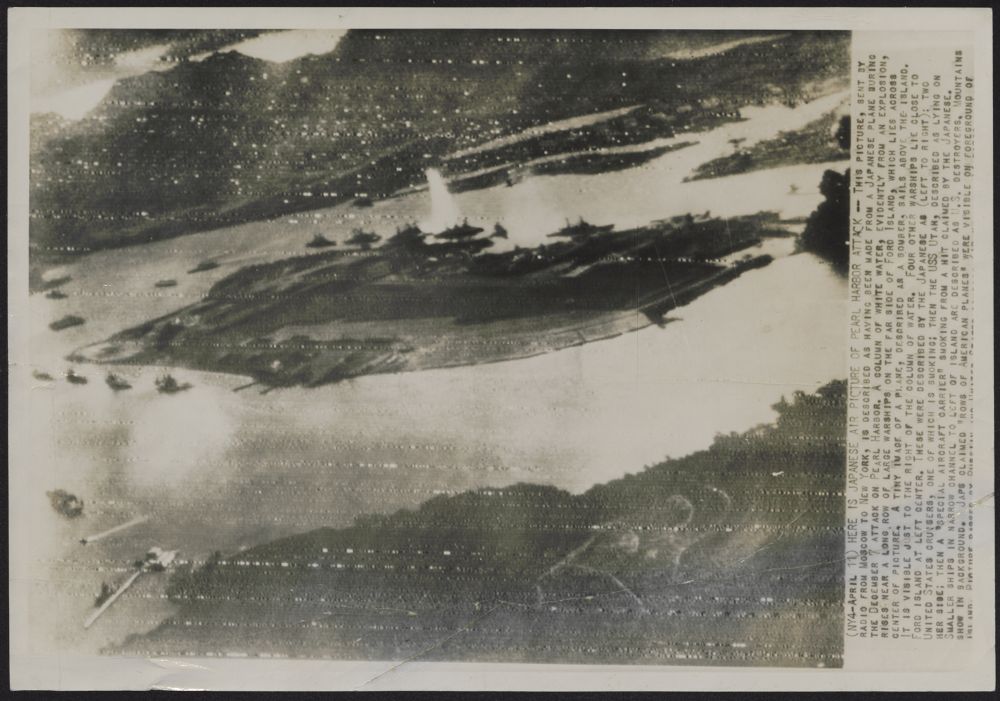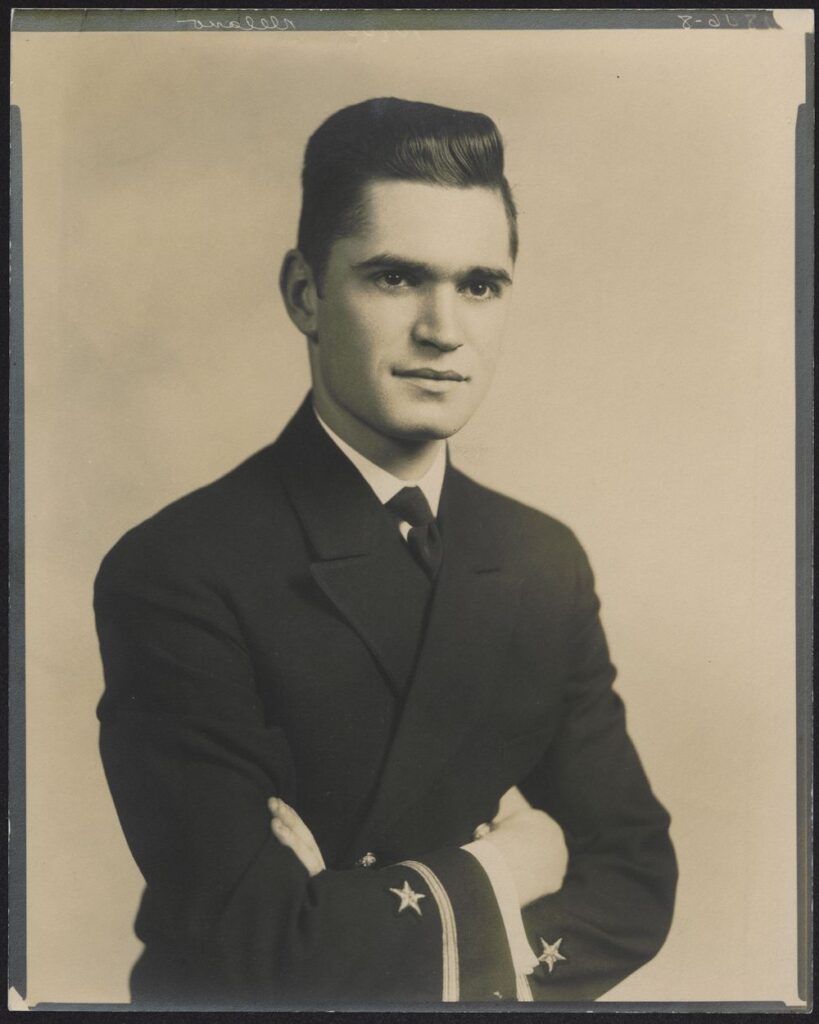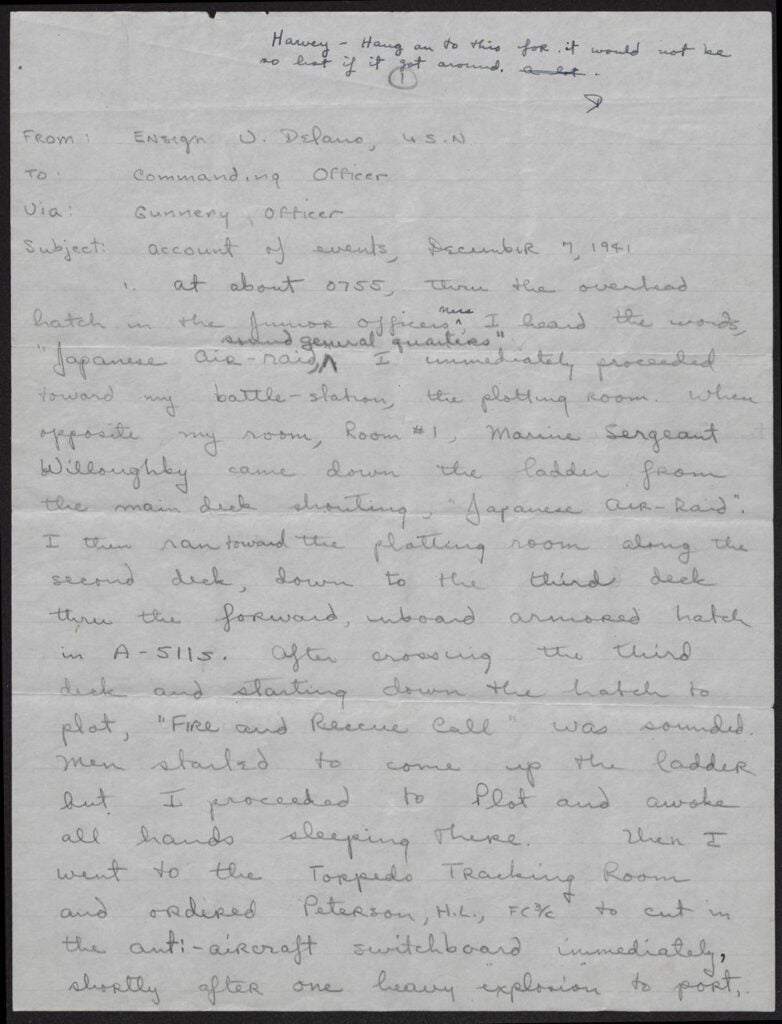National Pearl Harbor Remembrance Day: The Experiences of Archie P. Kelley and Victor Delano
In commemoration of the 82nd anniversary of the attack on Pearl Harbor, Joyner Library Special Collections has chosen to highlight two specific collections from United States Naval officers who both served on the USS West Virginia during the attack.

This photograph is described as being taken by a Japanese pilot during the attack on Pearl Harbor on December 7th, 1941. The photograph’s description states that the image was sent from Moscow to Washington D.C. by radio. A column of white water, evidently from an explosion, rises near a long row of large warships on the far side of Ford Island, which lies across the center of the picture. A tiny image of a plane, described as a bomber, sails above the island. It is visible just to the right of the column of water. Four other warships lie close to Ford Island at left center. These were described as (left to right): two United States cruisers, one of which is smoking; then the USS Utah, described as lying on her side; then a “special aircraft carrier” smoking from a hit. Smaller ships in the narrow channel left of the island are described as U.S. destroyers. Image from the Victor Delano Papers (#539), East Carolina Manuscript Collection, J. Y. Joyner Library, East Carolina University, Greenville, North Carolina, USA.
Archie P. Kelley was born in 1918 in Washington D.C. Born into a naval family, Kelley’s father, Frank H. Kelley, graduated from the U.S. Naval Academy in 1910 and rose to the rank of Rear Admiral in the U.S. Navy. Following his father’s footsteps, Archie Kelley attended the U.S. Naval Academy, graduating in 1941, and was assigned to the USS West Virginia. On the morning of December 7, 1941, the USS West Virginia was positioned with seven other US battleships along “Battleship Row” when the Imperial Japanese Navy Air Service launched their surprise attack. Kelley, who was lucky enough to survive the attack, described his experiences that morning in this 1942 letter to

Typescript of correspondence between Archie P. Kelley and his father, Captain Frank H. Kelley, January 19, 1942. Kelley would explain the coded language he used in a 1999 letter to The Arizona Republic. Archie P. Kelley Papers (#822), East Carolina Manuscript Collection, J. Y. Joyner Library, East Carolina University, Greenville, North Carolina, USA.
his father, U.S. Navy Captain Frank H. Kelley. The senior Kelley was serving as a senior officer aboard the USS West Point and was evacuating British citizens from Singapore during an aerial bombardment of the island by the Japanese military at the time of his son’s letter. The interesting part of the letter is the younger Kelley’s use of coded language to ensure his writing would make it pass military censorship that was ceasing any correspondence at the time that was deemed to include classified information. Kelley specifically chose to write to his father instead of his mother or other family members because he knew that due to his rank in the U.S. Navy. Archie Kelley wrote a letter to The Arizona Republic in 1999 in which he explained his reasoning for writing to his father and decoded the language used in the 1942 letter to his father
Following the attack on Pearl Harbor, Kelley remained in Hawaii, serving first with a group of top-secret codebreakers before being assigned as the navigator officer for the USS West Virginia. (In an oral history interview with the National WWII Museum, Kelley explained that he was assigned to this position even though the ship was damaged due to the U.S. Military’s desire to hide the initial toll of the attack from the general population). Kelley was eventually reassigned to the USS Gansevoort as the ship’s gunnery officer. While aboard the Gansevoort, Kelley participated in the Guadalcanal Campaign and Tarawa, before being promoted to the executive officer of the USS Frazier. Kelley was then enrolled at MIT where he studied naval architecture. During his time at MIT, Kelley was introduced to the study of nuclear physics, resulting in him being sent to Bikini Atoll where he became part of an experimental group that was charged with figuring out how to decontaminate ships that had become radioactive due to the military’s nuclear testing program. Kelley’s work in Bikini Atoll earned him another promotion, this time working under Admiral Hyman G. Rickover who oversaw the development of the U.S. Navy’s nuclear program. Kelley was a part of the team that developed the second nuclear-propelled submarine, the USS Seawolf. Kelley retired from the U.S. Navy as a captain in 1978.

Victor Delano. Image from the Victor Delano Papers (#539), East Carolina Manuscript Collection, J. Y. Joyner Library, East Carolina University, Greenville, North Carolina, USA.

A handwritten account of Victor Delano’s experiences during the attack on Pearl Harbor. Victor Delano Papers (#539), East Carolina Manuscript Collection, J. Y. Joyner Library, East Carolina University, Greenville, North Carolina, USA.
Victor Delano was also born into a distinguished naval family and would follow his father into service. Born on December 20, 1919, Delano spent time in various parts of the country before enrolling in the U.S. Naval Academy in 1937. After graduating with distinction, Delano was also assigned to the USS West Virginia and was present on the battleship at the time of the attack on Pearl Harbor. In an account of his experience that day, written in 1943, Delano recalls that he was reading the New Yorker when the Japanese attack began and he goes into great detail explaining where he was, what he was doing, and the various reports he was receiving during and after the attack.
After surviving the attack on Pearl Harbor, Delano was assigned to the USS Pennsylvania before being transferred to the USS San Juan where he served as the ship’s Radar Officer. After serving on the USS San Juan for two years, Delano was reassigned to the USS Wedderburn in December 1943, where he served first as Gunnery Officer before being promoted to Executive Officer. While aboard the USS Wedderburn, Kelley participated in the Battle of Surigao Strait and the third fleet operations against Okinawa and the Japanese mainland.
Following the war, Delano enrolled in the Ordnance Engineering program at the Naval Postgraduate School followed by MIT where he graduated with a Master of Science in Nuclear Physics in 1949. Following his studies, Delano was assigned to the Los Alamos Scientific Laboratory where he served as Program Director for the Department of Defense Atomic Weapons Effects Tests, Task Group 3.1, Operation Greenhouse. Delano would later serve on three additional US Navy battleships following his time in Los Alamos, seeing action in the Korean Conflict, before being named the head of the Congressional and Policy Coordination Board for the Office of the Chief of Naval Operations. Victor Delano officially retired from the U.S. Navy on December 1, 1969. Victor Delano passed away on August 25, 2014.
Sources:
- Archie Kelley Interview, The National WWII Museum, https://www.ww2online.org/view/archie-kelley, 3 August 2016.
- Archie P. Kelley Oral History Interview (#OH0197), East Carolina Manuscript Collection, J. Y. Joyner Library, East Carolina University, Greenville, North Carolina, USA.
- Archie P. Kelley Papers (#822), East Carolina Manuscript Collection, J. Y. Joyner Library, East Carolina University, Greenville, North Carolina, USA.
- Delano, Victor. Oral History Interview with Victor Delano, audio recording, Date Unknown; Fredericksburg, Texas. (https://texashistory.unt.edu/ark:/67531/metapth1607660/: accessed November 17, 2023), University of North Texas Libraries, The Portal to Texas History, https://texashistory.unt.edu; crediting National Museum of the Pacific War/Admiral Nimitz Foundation.
- Schudel, Matt. “Victor Delano, Retired Navy Captain and Pearl Harbor Survivor, Dies at 94.” The Washington Post, September 18, 2014. https://www.washingtonpost.com/local/obituaries/victor-delano-retired-navy-captain-and-pearl-harbor-survivor-dies-at-94/2014/09/18/937933c8-3eaf-11e4-b0ea-8141703bbf6f_story.html.
- Victor Delano Papers (#539), East Carolina Manuscript Collection, J. Y. Joyner Library, East Carolina University, Greenville, North Carolina, USA.